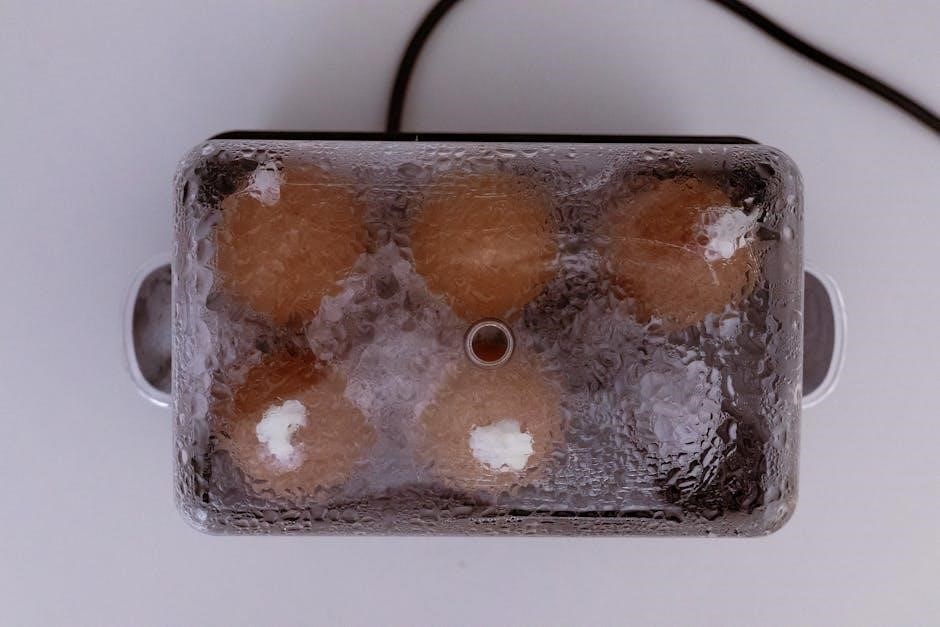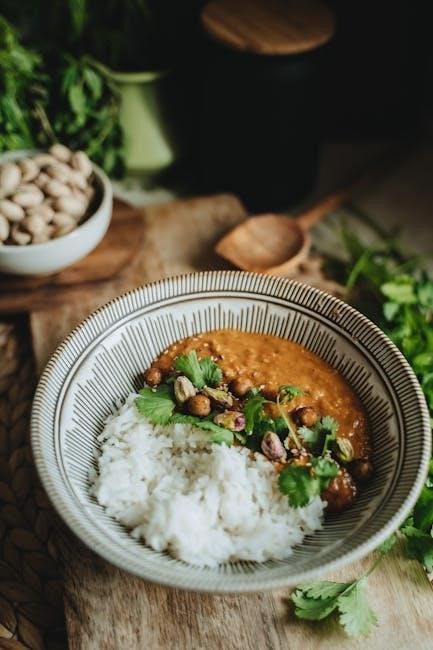tefal rice cooker steamer instructions
Tefal Rice Cooker Steamer Instructions: A Comprehensive Guide
Welcome! This guide offers comprehensive instructions for your Tefal rice cooker steamer. Learn about its features, setup, and usage. Discover the secrets to perfect rice and steamed dishes. Master your appliance with our expert tips!
Tefal rice cooker steamers offer a convenient and versatile solution for preparing perfect rice and healthy steamed meals. These appliances combine the functionality of a rice cooker with the benefits of steaming, allowing you to cook grains and vegetables simultaneously. Tefal models are known for their ease of use, consistent results, and innovative features like spherical pots for enhanced cooking.
This comprehensive guide will walk you through every step of using your Tefal rice cooker steamer, from initial setup to advanced cooking techniques. Whether you’re a seasoned cook or a beginner, you’ll find valuable information to help you get the most out of your appliance. We’ll cover everything from cooking different types of rice to steaming vegetables, cereals, and more. With Tefal, achieving culinary perfection has never been easier.

Unboxing and Initial Setup
The first step to enjoying your Tefal rice cooker steamer is proper unboxing and setup. Carefully remove all components from the packaging, including the rice cooker itself, the spherical pot, steaming basket, measuring cup, and any included utensils. Ensure all printed documents are taken out. Inspect each part for any damage incurred during shipping.
Before first use, thoroughly clean the spherical pot and steaming basket with a soft sponge and mild dish soap. Rinse well and dry completely. Place the rice cooker on a flat, stable, and heat-resistant surface, ensuring adequate ventilation around the appliance. Familiarize yourself with the control panel and its various functions. Refer to the user manual for detailed diagrams and explanations of each button. Taking these initial steps will ensure safe and efficient operation of your Tefal rice cooker steamer.
Understanding the Components
Your Tefal rice cooker steamer comprises several key components, each designed for specific functions. The spherical pot, often with a non-stick coating, is the heart of the cooker, ensuring even heat distribution for perfectly cooked rice. The steaming basket allows for simultaneous steaming of vegetables or other foods, maximizing efficiency. The measuring cup ensures accurate rice-to-water ratios, critical for consistent results.
The control panel features various buttons for selecting cooking modes, setting timers, and initiating the keep-warm function. The lid, equipped with a secure locking mechanism, traps steam and pressure for optimal cooking. Understanding the purpose of each component is essential for utilizing the full potential of your Tefal rice cooker steamer, allowing you to create a variety of delicious and healthy meals with ease.
Spherical Pot Features
The spherical pot is a standout feature of many Tefal rice cookers, designed to enhance cooking performance. Its unique shape promotes optimal heat circulation, ensuring rice cooks evenly from all angles. This leads to improved texture and flavor compared to traditional flat-bottomed pots. The non-stick coating prevents rice from sticking, making serving and cleaning effortless. The pot’s durable construction ensures longevity, withstanding high temperatures and frequent use.
The spherical design also contributes to better heat retention, keeping rice warm for extended periods without drying out. Some models feature multi-layer construction for enhanced heat distribution and durability. When selecting a Tefal rice cooker, consider the spherical pot’s capacity and material to ensure it meets your cooking needs. This innovative design element elevates the cooking experience, delivering consistently delicious results.
Steaming Basket Functionality

The steaming basket included with many Tefal rice cookers adds versatility to your cooking. This accessory allows you to steam vegetables, fish, and other foods simultaneously while cooking rice. The steaming basket sits above the rice, utilizing the steam generated during the cooking process. This method preserves nutrients and flavors, resulting in healthier and more flavorful meals.
Using the steaming basket is straightforward: simply place your chosen ingredients in the basket, add water to the rice cooker pot as directed, and start the cooking cycle. The steam will cook the food in the basket while the rice cooks below. Ensure the food in the basket is cut into uniform sizes for even cooking. This functionality makes your Tefal rice cooker a multi-purpose appliance, simplifying meal preparation and expanding your culinary options.
First Use: Preparation and Cleaning
Before using your Tefal rice cooker steamer for the first time, proper preparation and cleaning are essential. Begin by unboxing all components and removing any packaging materials. Familiarize yourself with each part, including the spherical pot, steaming basket, and measuring cup. Wash the spherical pot and steaming basket thoroughly with warm, soapy water and a non-abrasive sponge.
Rinse them completely and dry with a soft cloth. Wipe the exterior of the rice cooker with a damp cloth. Ensure all parts are completely dry before assembling the unit. It’s also advisable to run a test cycle by adding water to the pot and selecting the “cook” function to eliminate any residual manufacturing odors. Discard the water after the cycle is complete. Your Tefal rice cooker is now ready for its first use.
Cooking White Rice: A Step-by-Step Guide
Cooking perfect white rice with your Tefal rice cooker is simple. First, measure your desired amount of rice using the provided measuring cup. Rinse the rice once or twice to remove excess starch, which helps prevent stickiness. Place the rinsed rice into the spherical pot.
Next, add water according to the rice-to-water ratio (refer to the next section for details). Ensure the rice is evenly distributed in the pot. Place the pot inside the rice cooker, close the lid securely, and select the “White Rice” cooking mode. Press the “Start” button to begin cooking. The rice cooker will automatically determine the cooking time based on the quantity of rice and water.
Once cooked, the rice cooker will switch to “Keep Warm” mode. Allow the rice to steam for 10-15 minutes before opening the lid. Fluff the rice with a rice paddle before serving.
Rice to Water Ratio for White Rice
Achieving the perfect consistency for your white rice hinges on the correct rice-to-water ratio. As a general guideline, a 1:1.5 ratio (rice:water) typically yields excellent results. For every one cup of white rice, add one and a half cups of water. This ratio may need slight adjustments depending on personal preference and the specific type of white rice used.

For softer rice, you can add a tablespoon or two of extra water. Conversely, for firmer rice, reduce the water slightly. It is essential to use the measuring cup provided with your Tefal rice cooker to ensure accurate measurements. Consistency in measurement is key to consistent results. Always refer to the user manual for specific recommendations for your model.

Measuring Rice and Water Accurately
Accurate measurement is critical to achieving perfectly cooked rice every time. To ensure consistency, always use the measuring cup specifically provided with your Tefal rice cooker. Avoid using standard kitchen measuring cups, as they may differ slightly in volume.
When measuring rice, level off the cup with a straight edge to remove any excess. For water, use a liquid measuring cup and ensure it’s placed on a flat surface to read the measurement accurately at eye level. Consistency is key. Always use the same measuring tools and techniques for both rice and water. Slight variations in measurement can significantly impact the final texture and consistency of your rice.

Refer to your Tefal rice cooker’s user manual for precise capacity details and any specific measuring recommendations related to your model.

Cooking Time for White Rice
The cooking time for white rice in your Tefal rice cooker depends on several factors, including the quantity of rice and the specific model of your appliance. Generally, for a standard quantity of white rice (e.g., 1-2 cups), the cooking time will range from 25 to 35 minutes.
Your Tefal rice cooker is equipped with an automatic cooking cycle that detects when the rice is cooked and switches to a “keep warm” mode. Allow the rice to sit in the “keep warm” mode for an additional 10-15 minutes after the cooking cycle is complete. This allows the rice to steam and fully absorb any remaining moisture, resulting in a fluffier texture. Avoid opening the lid during the cooking process. Refer to the user manual.

Cooking Other Types of Rice
Your Tefal rice cooker is versatile and can cook various types of rice beyond standard white rice. However, different rice varieties require adjustments to water levels and cooking times to achieve optimal results. Brown rice, for instance, typically needs more water and a longer cooking time compared to white rice due to its outer bran layer.
Refer to the user manual. For example, brown rice might require an additional 1/2 cup of water per cup of rice and a cooking time of 40-50 minutes. Similarly, wild rice or basmati rice may have specific water-to-rice ratios and cooking time recommendations. Experimenting with small batches is advisable to find the perfect settings for your preferred rice types.
Adjusting Water Levels for Different Rice Varieties
The key to perfect rice lies in adjusting the water levels to match the specific type of rice you’re cooking. Different rice varieties absorb water at varying rates, influencing the final texture and consistency. For example, long-grain rice generally requires less water than short-grain rice. Brown rice, with its bran layer, needs significantly more water to soften properly. Refer to your Tefal rice cooker’s manual for specific recommendations.
As a general guideline, consider increasing the water by approximately 1/4 to 1/2 cup for every cup of brown rice compared to white rice. For stickier rice varieties like sushi rice, you might want to slightly reduce the water to prevent it from becoming too mushy. Always start with the recommended amount and adjust in future batches based on your desired outcome.
Cooking Time Variations for Different Rice Varieties

Besides water adjustments, cooking times also vary significantly depending on the type of rice used. White rice typically cooks faster, usually within 20-30 minutes in a Tefal rice cooker. Brown rice, due to its outer bran layer, requires a longer cooking time, often extending to 45-60 minutes. Other varieties, such as wild rice or specialty rice blends, may have unique cooking time requirements.
Always consult the rice cooker’s manual or the rice package instructions for specific guidance. Many Tefal rice cookers feature pre-programmed settings for different rice types, automatically adjusting the cooking time. If your model lacks such settings, monitor the rice closely during cooking and adjust the time accordingly. Remember that factors like the rice’s age and pre-soaking can also influence cooking time.

Steaming Vegetables and Other Foods
Your Tefal rice cooker isn’t just for rice! The steaming basket transforms it into a versatile steamer for vegetables, seafood, and more. To steam, add water to the pot as if cooking rice, but place the food in the steaming basket above the water level. Ensure the basket doesn’t touch the water. Cooking times vary based on the food and desired tenderness.
Leafy greens steam quickly (5-7 minutes), while denser vegetables like broccoli or carrots may take 10-15 minutes. Seafood, such as fish fillets or shrimp, steams in 8-12 minutes. Close the lid and use the appropriate cooking setting, often a “steam” or “quick cook” option. Monitor the food’s progress and adjust the steaming time as needed for perfect results; Enjoy healthy, flavorful meals with ease!
Using the Cereal Cooking Mode
Unlock the potential of your Tefal rice cooker beyond rice with the dedicated “Cereal” mode. This setting is perfect for cooking a variety of grains like buckwheat, lentils, and other cereals. To use this mode, first, measure your desired amount of cereal and rinse it thoroughly. Then, add the appropriate amount of water, referring to your user manual for specific ratios as different cereals require varying water levels for optimal cooking.
Place the cereal and water into the spherical pot, close the lid securely, and select the “Cereal” mode on the control panel. The rice cooker will automatically determine the cooking time based on the quantity of cereal and water. Once the cooking cycle is complete, the appliance will switch to the “Keep Warm” function. Fluff the cereal with a spoon or spatula before serving. Enjoy perfectly cooked, nutritious cereals with minimal effort!
Safety Precautions
Prioritizing safety is crucial when operating your Tefal rice cooker steamer. Always place the appliance on a flat, stable, and heat-resistant surface to prevent accidents. Ensure the cooker is properly closed before starting any cooking cycle to avoid scalding injuries from steam. Never immerse the main body of the rice cooker in water or any other liquid; this can cause electric shock.
Be cautious of hot steam escaping from the steam vent during cooking. Use oven mitts or pot holders when handling the hot spherical pot or steaming basket. Do not touch the heating plate during or immediately after use, as it remains hot. Always unplug the appliance when not in use and allow it to cool completely before cleaning. Keep the rice cooker out of reach of children and pets to prevent burns or other injuries.
Troubleshooting Common Issues
Encountering issues with your Tefal rice cooker steamer? Let’s troubleshoot! If the cooker doesn’t turn on, ensure it’s properly plugged into a functioning outlet. Check that the inner pot is correctly placed inside the cooker. If the rice is undercooked, verify the rice-to-water ratio and cooking time are accurate. For overcooked rice, reduce the water slightly in future attempts.
If the rice cooker is leaking, make sure the inner pot is not overfilled and is properly seated. If the steam vent is blocked, carefully clean it to ensure proper steam release. If you notice a burning smell, immediately unplug the cooker and inspect for any food debris or spills on the heating plate. Refer to the user manual for specific error codes or contact Tefal customer support for further assistance.
Cleaning and Maintenance
Proper cleaning and maintenance are crucial for the longevity of your Tefal rice cooker steamer. Always unplug the appliance and allow it to cool completely before cleaning. Remove the inner pot, steaming basket, and any other removable parts. Wash them with warm, soapy water using a non-abrasive sponge. Rinse thoroughly and dry completely before reassembling.
Wipe the exterior of the rice cooker with a damp cloth. Avoid immersing the base unit in water. For stubborn stains or food residue, use a mild cleaning solution. Regularly clean the steam vent to prevent blockages. Check for any debris or spills on the heating plate and clean as needed. Store the rice cooker in a cool, dry place when not in use. Descale the inner pot regularly to remove mineral buildup. Refer to the user manual for specific cleaning instructions and recommended descaling solutions.
Energy Saving Tips
To maximize energy efficiency with your Tefal rice cooker steamer, consider these tips. Only cook the amount of rice or food you need to avoid leftovers and reheating. Use the appropriate water level for the quantity of rice to optimize cooking time and energy consumption. Avoid opening the lid frequently during cooking, as this releases heat and increases cooking time.
Unplug the rice cooker when not in use to prevent standby power consumption. If your model has a keep-warm function, use it sparingly, as it consumes energy to maintain the temperature. Consider cooking larger batches of rice and freezing portions for later use. This reduces the frequency of cooking and saves energy. Regularly clean the heating plate to ensure efficient heat transfer. Choose energy-efficient recipes that require shorter cooking times. By following these tips, you can minimize energy usage and reduce your electricity bill.
Accessing User Manuals and FAQs Online
Need help with your Tefal rice cooker steamer? Access user manuals and FAQs online for quick solutions. Visit the official Tefal website for comprehensive support. Navigate to the “Support” or “Customer Service” section. Search for your specific rice cooker model using the model number. Download the user manual in PDF format for detailed instructions. Browse the FAQs for answers to common questions.
Explore troubleshooting tips and maintenance guidelines. Check for video tutorials on setup and usage. Join the Tefal community forum to connect with other users. Find information on warranty and repair services. Access recipe ideas and cooking guides. Stay updated with the latest product information. Utilize the online resources for a seamless cooking experience. Accessing these resources ensures you maximize the potential of your appliance.
